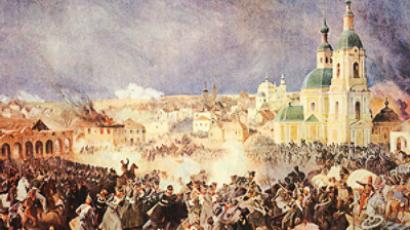Auschwitz-Birkenau: a place not to be revisited
Exactly 70 years ago, on June 14, 1940, the first rail convoy with prisoners arrived in Auschwitz.
Nearly 10 million people were killed – the estimated number of deaths in Nazi concentration camps during the Second World War.
Jews, Gypsies, Poles, Russians, mentally and physically disabled people, homosexuals, and intellectuals were all murdered by Nazi Germany.
Videos shown during the Nuremberg trials allowed the world at large to see the true extent of Nazi atrocities. But no matter how horrifying such images look, they are still a mere reflection of the memories of those who survived the hell.
Out of the hundreds of camps the Germans ran, Auschwitz-Birkenau was one of the worst. Millions were killed there in the space of just three years, and those who survived still shudder at the mention of the camp.
Ekaterina Davydenkova survived both Auschwitz and Flossenburg, but the nightmares still haunt her to this day.
“When we first arrived in Auschwitz-Birkenau, we saw the camp through the fog. These two huge buildings with chimneys loomed out, with smoke coming out of them. We all thought they were the kitchens,” she recalls. “And the Nazi soldiers made us form a line that led to these two buildings, and we stood there, barefoot, in the cold, just waiting for something. As I got nearer the building, I noticed the smell and thought, ‘Someone has burnt the meat’. And then a cart came out, loaded to the brim with – well, I couldn’t make out what it was. But it smelled horrible. I was scared then, more than before, and didn't know why. Only when a dead body fell off the cart right next to me, did I see what the cart was carrying and where the horrid smell was coming from. It was burnt human flesh.”
Ekaterina would have died the same way if it were not for one brave Polish girl:
“They took us to the gas chamber. We didn't know it was a gas chamber at first. They just told us to take our clothes off and get inside this building. First they poured boiling hot water on us, for about 15 minutes – and then freezing cold. After this, they usually turned on the gas. When the people died, the floors open, because they were automated, and the bodies fell into this pit. But this one girl, she just started screaming ‘We are political prisoners, political! You can't just kill us!’ She was so loud that the two SS soldiers on guard came in, and panicked, and called their superiors and they marched us all, naked, through the snow, to get tattooed.”
Auschwitz was the only camp to brand its prisoners this way. Ekaterina never removed hers, because it is not the number that triggers the memories.
She was eventually moved to Flossenburg in Bavaria, then managed to escape from a train in Prague while being transferred to the Mauthausen camp in Austria.
She joined the resistance and on May 9, 1945, she welcomed Soviet troops to the Czech capital.
Since then, she has married, had children, grandchildren, and lived through the collapse of the Soviet Union and her fair share of trials and tribulations.
There is nothing she cannot do, she says – apart from ever return to Auschwitz.














